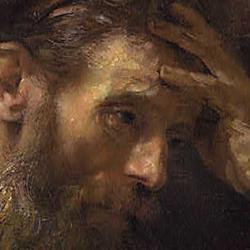The title of Benjamin Dunning’s Christ Without Adam summarizes one of the key themes of his book. He devotes chapters to Stanislas Breton, Alain Badiou, and Zizek, all of whom have written on Paul in recent years. In each case, though in different ways, they break the links that Paul forges between the first and last Adam.
Dunning’s interest is partly in the implications that this has for understanding sexuality. He argues that the church has always had struggled to fit Eve into the Adam-Christ parallel. They recognized the challenge, and came up with various solutions. The deletion of Adam from recent studies of Paul means that the question of Eve evaporates: “in the philosophers’ readings, the Adam-Christ typology is refigured such that Adam plays no anthropologically significant role. The result is that these readers cannot see (or simply refuse to see) the force of the problem that so exercised early Christian thinking about Pauline typology. Reading Paul’s anthropology in terms of Christ without Adam works to render Eve’s difference putatively incidental – and thus effectively ignorable.” It’s a striking result: By treating Paul as an apostle of “the universal,” recent studies have rolled back the clock on feminism (7).
Zizek’s Hegelianized, Lacanian Paul is the most radical in that he identifies Christ with Adam and claims that “the Fall is in itself already its own self-sublation, the wound is in itself already its own healing.” The fall is, in short, already redemption (78). Following Hegel, Zizek claims that evil resides not in the fall itself but in “the gaze which perceives Evil.” The way out of this misrecognition is “to insist on the absolute identity of the two gestures: God does not first push us into Sin in order to create the need for Salvation, and then offer Himself as the Redeemer from the trouble into which he got us in the first place; it is not that the Fall is followed by Redemption: the Fall is identical to Redemption, it is ‘in itself’ already Redemption” insofar as both fall and redemption are different ways of looking at the “explosion of freedom” (quoted, 78-9).
The indifferentiation of Adam and Christ is ground, Dunning argues, for the indifferentiation of Adam and Eve: “By collapsing the interval between the two paradigmatic humans, Adam and Christ, so that it does not function as a ‘space’ (both temporal and conceptual) of anthropological negotiation, Zizek’s reading renders the problematic of sexual difference that haunts that space . . . seemingly indifferent or inoperative” (82).
We live in a strange intellecutal climate: Paul, the thinker of difference set in opposition radical Lacanian Marxist universalists.














